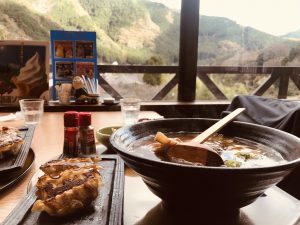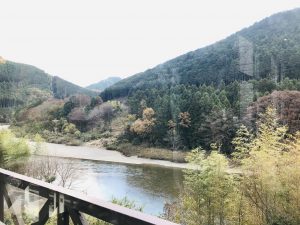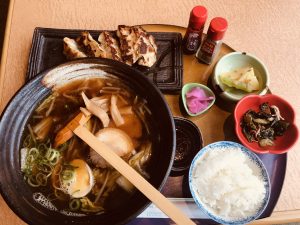My first impression of Sato in Yoshino Town was that their menu was so big it could be published. It was contained in two separate bindings, with numerous loose pages added through the years into each one. Sadly (but conveniently) it has since been organized into one neat binding with a dozen or so categories, but still contains its wide range of food from rice bowls and lunch plates to omelettes and pizza. Within in that range are noodle bowls as well, which also come in the huge size that Sato is famous for. Another term for ramen in Japan is Chuka-men, or “Chinese noodles”. I ordered the Chuka-men combination with gyoza, and enjoyed the great scenery while I waited for my food. Sato offers a wide view of the endless mountains of Yoshino cedar, and the calming Yoshino River running below.
Another term for ramen in Japan is Chuka-men, or “Chinese noodles”. I ordered the Chuka-men combination with gyoza, and enjoyed the great scenery while I waited for my food. Sato offers a wide view of the endless mountains of Yoshino cedar, and the calming Yoshino River running below.  My food eventually arrived on a tray that seemed like it could cover the entire table, and in addition to my noodles and gyoza, included rice, stewed vegetables, and pickles. My bowl of noodles had a soy sauce based broth with slices of pork, half a hard-boiled egg, green onions, and popular Japanese vegetables like napa cabbage and bamboo shoots. The gyoza was perfect! Crispy, flavorful, and huge! After finishing everything on my tray, I wasn’t sure if I’d be able to walk out the door.
My food eventually arrived on a tray that seemed like it could cover the entire table, and in addition to my noodles and gyoza, included rice, stewed vegetables, and pickles. My bowl of noodles had a soy sauce based broth with slices of pork, half a hard-boiled egg, green onions, and popular Japanese vegetables like napa cabbage and bamboo shoots. The gyoza was perfect! Crispy, flavorful, and huge! After finishing everything on my tray, I wasn’t sure if I’d be able to walk out the door. Signed photos and autographs near the entrance show how popular of a stop Sato is among celebrities who pass through. Sato is also a very popular place among the locals, and even with all that fame, the staff always makes an effort to remember faces and names. Even if it is your one and only visit there, I am sure they will welcome you very warmly! As I mentioned, they still have a giant menu, so I recommend going there multiple times and trying something new every time.
Signed photos and autographs near the entrance show how popular of a stop Sato is among celebrities who pass through. Sato is also a very popular place among the locals, and even with all that fame, the staff always makes an effort to remember faces and names. Even if it is your one and only visit there, I am sure they will welcome you very warmly! As I mentioned, they still have a giant menu, so I recommend going there multiple times and trying something new every time.
We offer many experiences in Yoshino, and if you have a chance to participate in one, Sato would be a great place to visit as well! Here are some of our experiences.
No. 162 – Traditional Crafts of Nara: Making Yoshino Washi Paper
No. 192 – Adventure Caving
No. 330 – An Introduction to Yoshinoyama
